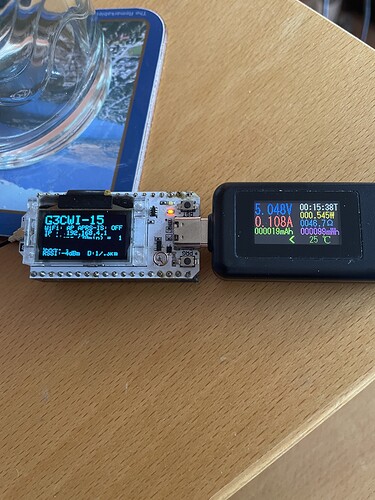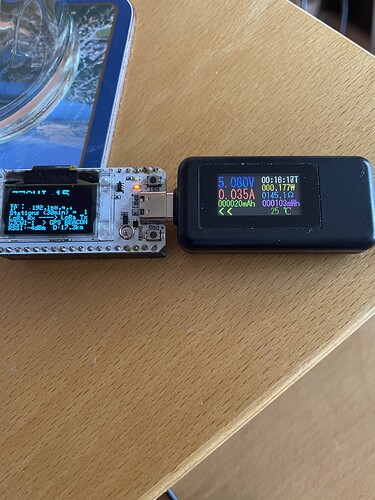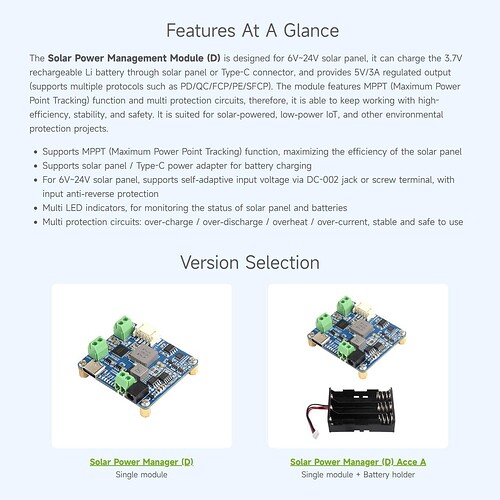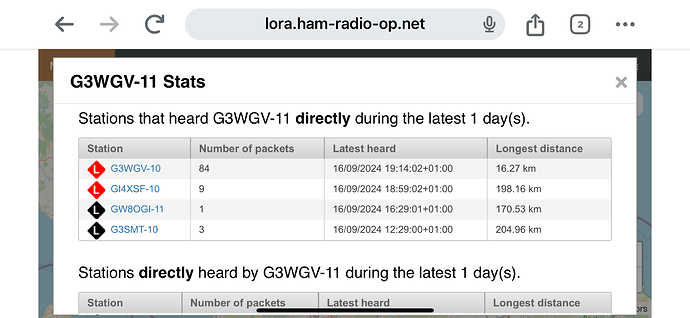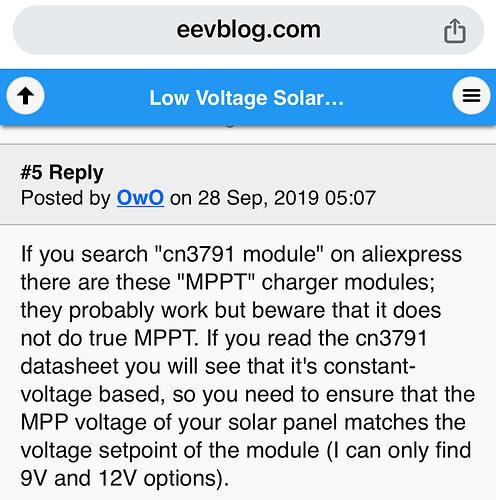I tried it on a Heltec WiFi LoRa V3. Initially it appeared to work but there was something wrong. In the end I pinched your WiFi code and replaced the code in Rich’s latest version. That fixed the WiFi AP timeout. Results before and after below.
Heltec V3 running on a x30
Heltec Tracker running on a aliexpress 20cm 433mhz grey stick
Comparing the top packet am I right in thinking the signal is better on the x30 but the signal to noise is better on the grey stick?
I don’t think you should draw any conclusions on such limited data.
true enough.
No, the RSSI and SNR is better on the X30 because it’s less negative (by 29dB and 18.75dB respecively)
That’s a lot, but Richard is correct about limited data
Rick
LoRa APRS was fairly busy down here this last weekend, with quite a few positions digipeated via M0JKS-1 (which is just over 200 kms from my iGate) to add to the ones heard directly.
For my new digipeater I have bought a Waveshare Solar Charger (D). I have been testing this in various scenarios and I think I have discovered a problem. The Solar Charge chip is set for an MPPT voltage of 6 Volts with no way to adjust this. My panel is nominally 12 - 15 Volts and the charger switches off when the panel is in full sunlight. There is no easy way to change this as the relevant components are the size of grains of sand. Bodging a resistor in is unlikely to end well. I could get a 6 Volt panel, or another charge board. Any ideas?
From the link you posted, it suggests that the solar panel input is self adaptive from 6 - 24v.
Maybe yours is faulty and could be exchanged…?
Is does “suggest” that. But a look at the circuit shows that it can’t actually do what is suggested.
Further thought is that switching the panel off in full sunlight might not be a fault. If the charge controller doesn’t need that energy to charge the battery it would have to dump it as heat so disconnecting the panel makes sense. It also leads to the possibility that panels could actually be too large? Is there an optimal size? I suspect that more sophisticated charge controllers can harvest the energy better? I read suggestions elsewhere that the CN3791 might not really be an MPPT controller? Having to “define” the MPPT point in the hardware is a giveaway. @m1geo probably knows about this stuff.
For simple applications, CV tracking is probably sufficient, though it loses efficiency in low light situations.
The CN3791 uses a resistive voltage divider to set the target working voltage of the panel, so if you have a mismatched one it would be simple to change (or use a potentiometer to allow an adjustment range).
The chip aims for 1.205 volts to be present on pin 6 - look on your module for a pair of resistors dividing the panel voltage.
Rick
For anyone experimenting with solar power I have now given up with the Solar Power Manager Module (6V-24V) (D). I am not sure if mine is faulty in some way but it certainly doesn’t work in my application. I have ordered another Waveshare module (a different one) and hopefully that will do the job. I will report back.
An interesting glitch with my iGate recently; there was a brief WiFi issue on Friday evening, and for some reason the iGate picked up a different IP address following the brief loss of contact. This seemed to confuse it mightily, and it stopped doing anything useful, so it was off-air all yesterday. It got power-cycled this morning and has resumed normal service. I have had a talk with the DHCP server and bound the iGate’s MAC to a fixed IP address (which will also prevent any other device grabbing it), so, hopefully it won’t fail that way again…
That high-altitude balloon SP0LND whose APRS beacons on 439MHz LoRa were received by many iGates last month is heading towards Europe again, on its fourth “orbit”. This is its predicted track over the next day or so:
It also carries an HF WSPR beacon (SP0LND-32) for tracking over the sea, but its UHF LoRa frequencies (SP0LND-12) are: 434.855, 433.775 & 439.9125 MHz. That blue circle indicates its radio horizon (400km radius, from an altitude of 12km), so it may be just in range of IGates in the South-West of the UK tomorrow morning. However as it’s powered from little solar panels, it might not start transmitting until the Sun is higher in the sky.
My White Peak Digipeater in Earl Sterndale is back in position. The new solar manager from PiHut arrived yesterday and seems to work just fine (unlike the other one). I also upgraded to an Eco Worthy 10W 18V panel which looks quite professional.
Nice, i cant even get the tracker to work! (see other thread)… must be some sort of witchcraft running these! ![]()
![]()
Alan
Someone called Madspy on GitHub, has created a great web tool that uses the log feature of the CA2RXU igate software. It interrogates the log files and populates the information onto a public web based map. The main feature that I like is that it shows packets that your station has received but will not be shown on APRS, because another station received the same packet, and so filtered out. This makes it a very useful iGate diagnostic tool.
More info can be found here on GitHub here Public syslog server + signal tracking web page / API · Issue #177 · richonguzman/LoRa_APRS_iGate · GitHub
Thanks for this: I have been looking for a free syslog server to see what’s going on with my iGate - this looks really interesting! I’ll report back when i’ve played around a bit more.
I have been playing with queries in CA2RXU iGate firmware. The list of available queries is here
I am finding them useful for remote iGate diagnostics and they are accessed by sending a message to your iGate.
